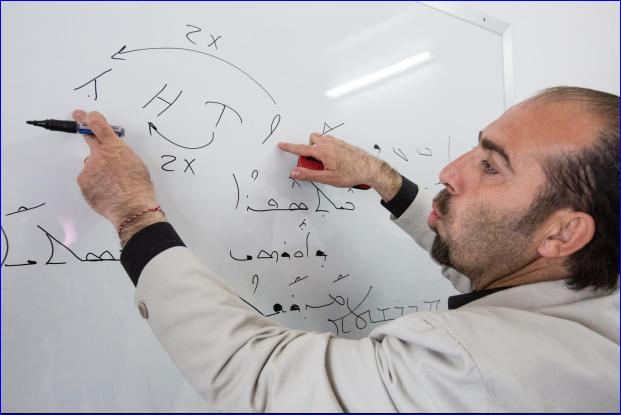PYD Impose Kurdish Education Curricula on Assyrians, Arabs in Syria

Teacher Jacob Lahmo explains Assyrians fonts. The language of the Assyrian Christians is now taught again in Syria but its speakers fear being marginalized. ( Sebastian Backhaus/Welt)
By Bar Daisan – May 2016
(AINA) — The Syrian Kurdish Democratic Union Party (PYD), which is the Syrian branch of the Kurdish Workers Party (PKK) from Turkey, and some attached allied non-Kurdish groups, declared a so-called autonomous federation in the northern part of Syria in March 2016. The PYD was strengthened by support from the Syrian regime to safeguard the northern border corridors to Turkey and recent military support by the U.S. led coalition to fight the ISIS. It seized the opportunity to establish a Kurdish state in the shadow of the Syrian crisis, at the expense of the rights of the non-Kurdish majority in the region.
Prior to 2012, Assyrians (also known as Chaldeans and Syriacs) living in the northern part of Syria constituted more than one third of the population, the Arabs approximately another third. Assyrians, as the indigenous population of the region and as a non-Kurdish ethnic group in the Hasaka governorate, have been seriously impacted by the PYD decision. While only a single Assyrian group, the Syriac Union Party, joined the Kurdish self-governance project, including the police and military structure created by the Kurds, the majority of the Assyrian civic organizations and half a dozen of their political parties in Qamishli and Hasaka oppose the Kurdish decision. In fact, the majority of the Arab population and many Kurdish organizations non-aligned with the PYD oppose autonomy.
The Syrian regime still maintains its presence in both cities in form of fiscal, administrative, banking, legal, security and military structures. The PYD has created partially a parallel structure of self-governance, including police and military. Tensions routinely arise between Syrian regime and Kurdish forces because of this, as the latest clashes show (see here and here). Besides tensions over quarters and strategic military positions, the parallel governing structures are causing serious practical problems for the population of the region, such as forced conscription to military service, additional taxes on businesses and Kurdish nationalistic education curricula imposed in private and public schools.
In November 2015, sixteen Assyrian and Armenian civic and religious organizations issued a statement protesting the enforcement of Kurdish self-administration in the Hasaka province (AINA 2015-11-02). The statement accused the PYD, among others, of expropriation of private property, illegal military conscription and interference in church school curricula. The statements opened with:
For over four years our country, Syria, is struggling with tragic events. War devastation and terrorism have caused all ethnic groups much suffering. But we, inhabitants of Al-Jazeera, have kept so precious nowadays ideals of peaceful coexistence between various communities of our province. Due to extraordinary situation and having safety in mind local Self-Administration was created, together with number of dependent institutions. Some of its regulations, however, are not properly prepared nor thoroughly measured. This causes valid concerns among various ethnic and national groups. While it is happening official authorities [of the Syrian regime] are still performing its fiscal, administrative, legal and military duties.
The criticism against the Kurdish approach was massively echoed by Assyrian federations from U.S., Australia and Europe (AINA2015-11-10) while also addressing illegal seizure of property, forced conscription and threats, pressure and targeted killings.
In an article for Global Independent Analytics, Maram Susli, an independent geopolitical analyst and commentator from Australia, outlined the reasons why a Kurdish enclave in Syria is a bad idea, undemocratic and could lead to ethnic cleansing and genocide.
The Old Testament is Slightly Rewritten
Fast forward to May 2016, more details are surfacing as Kurdish curricula are put into practice. The Middle East correspondent of the German Newspaper (Die Welt), Alfred Hackensberger, published an article where he cites talks with Assyrians collaborating with Kurds in Qamishli in, what he calls, the “building of a new state.”
Interviewing Nancy Eissa and her husband John, who lead the Assyrian Edessa Language Institute, Nancy Eissa says “In the new textbooks they [the Kurds] alter historical and geographical facts.” For example, Assyrian place names are changed to Kurdish names, Kurdish students are taught that King Nebuchadnezzar from the Old Testament married a Kurdish woman.
In fact, this development is not surprising. Back in autumn 2015, Kurdish language school curricula started to generate controversy for being too ideological and “prioritizing a single view over all others.”
Hackensberger writes in his article of Assyrian fears that Kurdish revisionism will eventually lead to conflict. Hackensberger states the Kurds systematically prepared their new curricula beginning in 2011, which is now being used as a blueprint for the Christians and Arabs in the region. The Kurds are trying to enforce this in the new joint bodies, for example in the so-called education committee.
However, “no independent decisions can be taken” in that education committee, says Malek Hanna, an Assyrian member of that committee who was interviewed by Hackensberger. According to Hanna, the chairman of the committee does not allow any vote without “certain people” being available, who actually do not have a legitimate voice there. These people are closely associated with the “party” — which is how the PYD is identified in the region. Hackensberger states that the partisans of the PYD make all important decisions in the education committee, even though they are not members of the committee.
“That’s against the rules of democracy,” says Hanna. “These people are radical hardliners who want to impose their Kurdish nationalism on everyone.”
© Assyrian International News Agency.

633913 155975You got a quite fantastic web site, Glad I observed it by way of yahoo. 282247